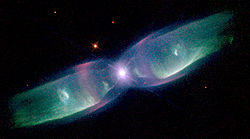- Planetary Nebula M2-9
-
For other uses of "Butterfly Nebula", see Butterfly Nebula (disambiguation).
Minkowski 2-9 (M2-9) 
Observation data
(Epoch J2000)Right ascension 17h 05m 37.952s[1] Declination -10° 08′ 34.58″[1] Distance 2,100 ly (650 pc)[2] Apparent magnitude (V) 14.7[1] Apparent dimensions (V) 115″[2] × 18″[citation needed] Constellation Ophiuchus Physical characteristics Radius 0.7 ly (0.2 pc)[2][a] Absolute magnitude (V) 5.6[b] Notable features Bipolar outflow, Bipolar nebula Other designations Twin Jet Nebula,[1]
PK 010+18.2
Butterfly Nebula,[1]
Wings of a Butterfly[3]
PNG 010.8+18.0See also: Planetary nebula, Lists of nebulae Minkowski 2-9, abbreviated M2-9, (and also known as Minkowski's Butterfly, the Wings of a Butterfly Nebula or just Butterfly Nebula, and Twin Jet Nebula) is a planetary nebula that was discovered by Rudolph Minkowski in 1947. It is located about 2,100 light-years away from Earth in the direction of the constellation Ophiuchus. This bipolar nebula takes the peculiar form of twin lobes of material that emanate from a central star. Astronomers have dubbed this object as the Twin Jet Nebula because of the polar jets believed to cause the shape of the lobes. Its form also resembles the wings of a butterfly. The nebula was imaged by the Hubble Space Telescope in the 1990s.
M2-9 represents the spectacular “last gasp”[citation needed] of a binary star system at the nebula's center. The primary component of this binary is the hot core of a star that reached the end of its main-sequence life cycle, ejected most of its outer layers and became a red giant, and is now contracting into a white dwarf. It is believed to have been a sun-like star early in its life. The second, smaller star of the binary orbits very closely and may even have been engulfed by the other's expanding stellar atmosphere with the resulting interaction creating the nebula. Astronomers theorize that the gravity of one star pulls some of the gas from the surface of the other and flings it into a thin, dense disk extending into space.[citation needed] Such a disk can successfully account for the jet-exhaust-like appearance of M2-9.[citation needed]
The nebula has inflated dramatically[4] due to a fast stellar wind, blowing out into the surrounding disk and inflating the large, wispy hourglass-shaped wings perpendicular to the disk. These wings produce the butterfly appearance when seen in projection. The outer shell is estimated to be about 1,200 years old (Schwarz et al. 1997).
 An animated gif of the precessing jet in M2-9 [1]
An animated gif of the precessing jet in M2-9 [1]
Contents
See also
Notes
References
- APoD (June 12, 2005), Astronomy Picture of the Day, NASA and Michigan Technological University (MTU), http://antwrp.gsfc.nasa.gov/apod/ap050612.html
- APoD (June 18, 2007), Astronomy Picture of the Day, NASA and Michigan Technological University (MTU), http://antwrp.gsfc.nasa.gov/apod/ap070618.html
- Hora, Joseph L.; Latter, William B. (1994), "The near-infrared structure and spectra of the bipolar nebulae M2-9 and AFGL 2688: The role of ultraviolet pumping and shocks in molecular hydrogen excitation", Astrophysical Journal, Part 1 (ISSN 0004-637X) 437 (1): 281–295, http://adsabs.harvard.edu/cgi-bin/nph-bib_query?1994ApJ...437..281H
- Livio, Mario; Soker, Noam (2001), "The "Twin Jet" Planetary Nebula M2-9", The Astrophysical Journal 552 (2): 685–691, arXiv:astro-ph/0010241, Bibcode 2001ApJ...552..685L, doi:10.1086/320567, http://adsabs.harvard.edu/cgi-bin/nph-bib_query?bibcode=2001ApJ...552..685L
- Savage, Don (December 17, 1997), "Hubble Witnesses the Final Blaze of Glory of Sun-Like Stars", Space Telescope Science Institute, http://hubblesite.org/newscenter/newsdesk/archive/releases/1997/38/text/
- Schwarz, H. E.; Aspin, C.; Corradi, R. L. M.; Reipurth, B. (1997), "M 2-9: moving dust in a fast bipolar outflow", Astronomy and Astrophysics 319: 267–273, Bibcode 1997A&A...319..267S, http://adsabs.harvard.edu/cgi-bin/nph-bib_query?bibcode=1997A%26A...319..267S
- SIMBAD (December 22, 2006), Results for PN M 2-9, SIMBAD, Centre de Données Astronomiques de Strasbourg, http://simbad.u-strasbg.fr/simbad/sim-id?protocol=html&Ident=PN+M2-9
External links
- NASA APoD 1997-12-23 & APoD 1999-03-21 & APoD 2004-02-01 & APoD 2005-06-12 & APoD 2007-06-18 M2-9: Wings of a Butterfly Nebula
Categories:- Planetary nebulae
- Ophiuchus constellation
Wikimedia Foundation. 2010.
